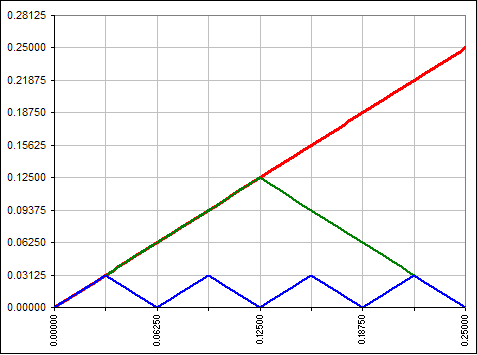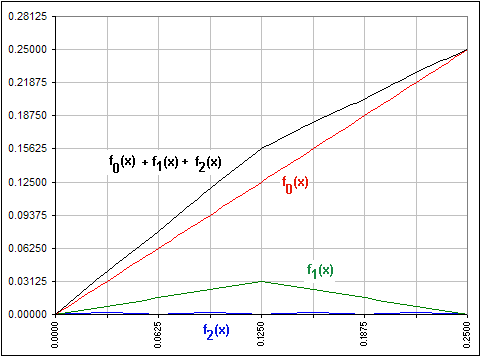| a Funny Function |
|
I'm looking for a particular kind of function ... something continuous everywhere, but differentiable nowhere.
We start with g(x) which looks like Figure 1A. In fact, g(x) = |x| for -1/2 < x < 1/2 and it's extended periodically. Note that g(x) = 0 when x = n, an integer ... and g(x) = 1/2 when x = (2n+1)/2. Then we construct g(4x) / 4 which looks like Figure 1B. >Huh?
Now we construct g(16x) / 16 which is zero when 16x = n or x = 1/16, 2/16 and ... >Yeah, I get it ... but then what? |  Figure 1A
|

This gives F(x) = Σ g(4nx)/4n, the sum going from n = 0 to n = ∞.
>I assume "F" stands for Funny Function, right?
You got it!
>So what does it look like?
Uh ... well ... I can't draw the whole infinite sum, but I can give you a few partial sums.
>And it's continous but nowhere differentiable?
Yes.
Let fn(x) = g(4nx)/4n so F(x) = f0(x) + f1(x) + f2(x) + ...
Then fn(x) has a "corner" (hence isn't differentiable) whenever it has a zero value
... and that occurs 4n times in 0 < x ≤ 1, namely where 4nx = 1, 2, 3 ... 4n or x = 1/4n, 2/4n, 3/4n ... 1.
Wherever any fn(x) fails to be differentiable, our Funny Function F(x) won't be differentiable.
Clearly, the sum of all fn(x) will then fail to be differentiable at infinitely many places in 0 < x ≤ 1 and, by periodic extension, to all x.
One of these places will lie in every interval (x0 - ε, x0 - ε) regardless of the values of x0 and ε > 0.
Since the set of points of non-differentiabiliy is everywhere dense on the x-axis, our Funny Function will be differentiable nowhere.
>And with so many corners, it isn't continuous, right?
No, no ... it's the uniformly convergent sum of continuous functions, is so it's continuous.
>Yeah, so where's the graph of F(x)?
The functions g(x) and g(4x) and g(16x) look like this:

If we reduce the size of each (as noted above) we'd get this:

>I don't see all those corners ...
Of course not. The maximum value of f2(x) is just 1/32 = 0.03125 and that's pretty small, eh?
>And this Funny Function is your invention?
Are you kidding? There are lots of such Funny Functions: everywhere continous but nowhere differentiable, everywhere differentiable but nowhere monotone, everywhere ...
>Do they have names?
Sure, like Kopcke functions.
Note that all of our fn(x) functions are periodic and have a Fourier Series expansion ... and the
Weierstrass Function is such an animal.
>And if I search for "Funny Functions" will I get some more?
I have no idea, but try it !
>Aha! Even the name "Funny Function" ain't yours !
Of course not. 
|
>So where did this probem come from?
There was a question concerning a function satisfying: f(-1) = 5, f(1) = 2, f(5) = 5 and f(8) = -1. The question concerned the existence of a point of inflection. An example is shown in Figure 2, where two parabolas are joined at x = 5 where there is a point of inflection. Now the question:
>I'd say no.
|  Figure 1A |

